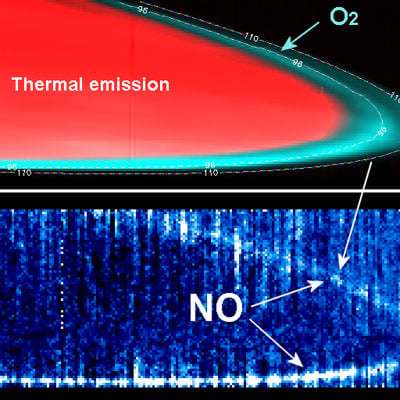[/caption] Venus is glowing in infrared! At least at night, anyway. The Venus Express spacecraft has observed an eerie glow in the night-time atmosphere of Venus. This infrared glow comes from nitric oxide and is showing scientists that the atmosphere of Earth's nearest neighbor is a temperamental place of high winds and turbulence. Since this glow is infrared, we can't see it with our eyes but lucky for us, the ESA's spacecraft is equipped with the Visible and Infrared Thermal Imaging Spectrometer (VIRTIS) instrument, which can see these wavelengths. A glow like this has never been detected in the atmospheres of Earth or Mars, even though nitric oxide molecules are present. So just why is Venus glowing, and what is this glow telling us?
"The nightglow can give us a lot of information," says Antonio García Muñoz, who was at the Australian National University when the research was carried out; he is now located at the Instituto de Astrofísica de Canarias, Tenerife, Spain. "It can provide details about the temperature, wind direction, composition and chemistry of an atmosphere."
VIRTIS has made two clear-cut detections of the so-called nightglow for nitric oxide at Venus. This is the first time such infrared detections have been made for any planet and provide a new insight into Venus's atmosphere
The nightglow is ultimately caused by the Sun's ultraviolet light, which streams into a planet's atmosphere and breaks the molecules up into atoms and other simpler molecules. The free atoms may recombine again and, in specific cases, the resulting molecule is endowed with some extra energy that is subsequently lost in the form of light. On the day-side of the planet, any atoms that do find their way back together are outshone by the sunlight falling into the atmosphere.
But on the night-side, where atoms are transported by a vigorous diurnal circulation, the glow can be seen with appropriate instruments, such as VIRTIS.
It also highlights a new mystery. "These results show that there could be at least twice as much hydrogen in the upper atmosphere of Venus than we thought," says Delva. The detected hydrogen ions could exist in atmospheric regions high above the surface of the planet; but the source of these regions is unknown. [caption id="attachment_26196" align="aligncenter" width="250" caption="Artist's impression shows Venus Express focussing on studying the peculiar atmosphere of Venus,"]
[/caption]
The nightglow on Venus has been seen at infrared wavelengths before, betraying oxygen molecules and the hydroxyl radical, but this is the first detection of nitric oxide at those wavelengths. It offers data about the atmosphere of Venus that lies above the cloud tops at around 70 km. The oxygen and hydroxyl emissions come from 90-100 km, whereas the nitric oxide comes from 110-120 km altitude.
Yet, even VIRTIS cannot see the nitric oxide nightglow all the time because it is often just too faint. "Luckily for us, Venus has a temperamental atmosphere," says García Muñoz, "Packets of oxygen and nitrogen atoms are blown around." Sometimes these become dense enough to boost the brightness of the nightglow, making it visible to VIRTIS.
Venus Express can observe the three nightglow emissions simultaneously, and this gives rise to a mystery. The nightglows from the different molecules do not necessarily happen together. "Perhaps when we have more observations, we will understand the correlation between them," says García Muñoz.
In order to do that, the VIRTIS team plans to continue monitoring the planet, building up a database of this fascinating phenomenon.
Source:
ESA
 Universe Today
Universe Today
